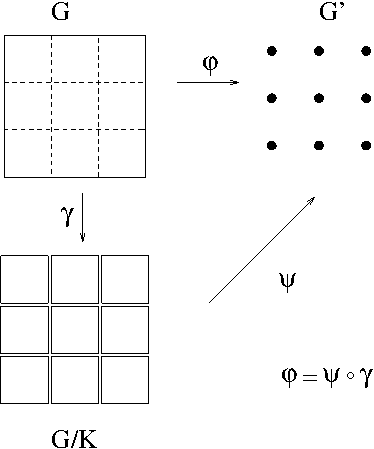The following theorem is called the Fundamental Homomorphism Theorem or the First Isomorphism Theorem.
Theorem. Let $G$ and $G’$ be groups, and $\varphi:G\longrightarrow G’$ an epimorphism (onto homomorphism). Then $G/K\cong G’$ where $K=\ker\varphi$.
Proof.
 Let $\gamma: G\longrightarrow G/K$ be the canonical homomorphism i.e. for any $a\in G$, $\gamma(a)=Ka$. Define $\psi: G/K\longrightarrow G’$ by
Let $\gamma: G\longrightarrow G/K$ be the canonical homomorphism i.e. for any $a\in G$, $\gamma(a)=Ka$. Define $\psi: G/K\longrightarrow G’$ by
$$\psi(Ka)=\varphi(a)$$for each $a\in G$. Then
- $\psi$ is well-defined:\begin{align*}Ka=Kb&\Rightarrow ab^{-1}\in K\\&\Rightarrow\varphi(ab^{-1})=e’\\&\Rightarrow\psi(Ka)=\varphi(a)=\varphi(b)=\psi(Kb).\end{align*}
- $\psi$ is a homomorphism:$$\psi(KaKb)=\psi(Kab)=\varphi(ab)=\varphi(a)\varphi(b)=\psi(Ka)\psi(Kb).$$
- $\psi$ is one-to-one:\begin{align*}\psi(Ka)=\psi(Kb)&\Rightarrow\varphi(a)=\varphi(b)\\&\Rightarrow\varphi(ab^{-1})=e’\\&\Rightarrow ab^{-1}\in K\\&\Rightarrow Ka=Kb.\end{align*}
- $\psi$ is onto: Let $b\in G’$. Then there exists $a\in G$ such that $\varphi(a)=b$ since $\varphi$ is onto. Now, $Ka\in G/K$ and $\psi(Ka)=\varphi(a)=b$.
Example. Let $S^1$ be the unit circle centered at the origin. Then it can be represented in terms of complex numbers as
$$S^1=\{e^{2x\pi i}:x\in[0,1)\}.$$Define a map $\varphi: (\mathbb{R},+)\longrightarrow(S^1,\cdot)$ by $$\varphi(x)=e^{2\pi ix}$$for each $x\in\mathbb{R}$. Then $\varphi$ is an onto homomorphism. The kernel of $\varphi$ is$$\ker\varphi=\mathbb{Z}.$$Hence, by the Fundamental Homomorphism Theorem
$$\mathbb{R}/\mathbb{Z}\cong S^1.$$Note that $\mathbb{R}/\mathbb{Z}$ can be viewed as the quotient set $\mathbb{R}/\sim$ where $\sim$ is an equivalence relation on $\mathbb{R}$ defined as follows: For all $x,y\in\mathbb{R}$,
$$x\sim y\ \mbox{if}\ x-y=n$$for some $n\in\mathbb{Z}$.
Theorem [Correspondence Theorem]. Let $\varphi: G\longrightarrow G’$ be a homomorphism. Let $K=\ker\varphi$, $H’\leq G’$ and $H=\varphi^{-1}(H’)=\{a\in G: \varphi(a)\in H\}$. Then $K\subset H\leq G$ and $H/K\cong H’$. If $H’\triangleleft G’$, then $H\triangleleft G’$.
Proof. Since $e\in K\subset H$, $H\ne\emptyset$. Let $a,b\in H$. Then $\varphi(a),\varphi(b)\in H’$. Since $H’\leq G’$, $\varphi(a)\varphi(b)^{-1}=\varphi(ab^{-1})\in H’$ and so, $ab^{-1}\in H$. Hence, $H\leq G$. Since $e’\in H’$, $K\subset H$. Let $\psi=\varphi|_H$. Then $\psi$ is a homomorphism from $H$ onto $H’$ and $\ker\psi=\ker\varphi=K$. Therefore, by the Fundamental Homomorphism Theorem $H/K\cong H’$.
Suppose that $H’\triangleleft G’$. Let $a\in G$ and $h\in H$. Then $\varphi(a)\in G’$ and $\varphi(h)\in H’$. Since $H’\triangleleft G’$, $\varphi(a)\varphi(h)\varphi(a)^{-1}=\varphi(aha^{-1})\in H’$ which implies that $aha^{-1}\in H$. Hence, $H\triangleleft G$.
Theorem [The Second Isomorphism Theorem]. Let $H\leq G$ and $N\triangleleft G$. Then $HN\leq G$, $H\cap N\triangleleft H$ and
$$H/H\cap N\cong HN/N.$$
Proof. Let $a,b\in HN$. Then $a=h_1n_1$ and $b=h_2n_2$ for some $h_1,h_2\in H$ and $n_1,n_2\in N$. Then
\begin{align*}
ab^{-1}&=h_1n_1(h_2n_2)^{-1}\\
&=h_1n_1(n_2^{-1}h_2^{-1})\\
&=h_1h_2^{-1}(h_2(n_1n_2^{-1})h_2^{-1})\in HN.
\end{align*}
So, $HN\leq G$. Clearly $H\cap N\triangleleft H$. Also clearly $N\leq HN$. Let $n_1\in N$. Then $\forall hn\in HN$,
$$(hn)n_1(hn)^{-1}=h(nn_1n^{-1})h^{-1}\in N.$$This means that $N\triangleleft HN$. Define $\varphi:H\longrightarrow HN/N$ by
$$\varphi(h)=Nh$$for each $h\in H$. Then $\varphi$ is clearly well-defined, a homomorphism. Let $Nhn\in HN/N$. Then $Nhn=hnN=hN=Nh$ and $\varphi(h)=Nh=Nhn$. So, $\varphi$ is onto.
\begin{align*}
h\in \ker\varphi&\Leftrightarrow \varphi(h)=Nh=N\\
&\Leftrightarrow h\in N\\
&\Leftrightarrow h\in H\cap N.
\end{align*}
So, $\ker\varphi=H\cap N$. Therefore, by the Fundamental Homomorphism Theorem
$$H/H\cap N\cong HN/N.$$
Theorem [The Third Isomorphism Theorem]. Let $\varphi: G\longrightarrow G’$ be an epimorphism. Let $K=\ker\varphi$, $N’\triangleleft G’$, and $N=\varphi^{-1}(N’)=\{a\in G: \varphi(a)\in N’\}$. Then
$$G/N\cong G’/N,$$or equivalently
$$G/N\cong(G/K)/(N/K).$$
Proof. Define $\psi: G\longrightarrow G’/N’$ by
$$\psi(a)=N’\varphi(a)$$for each $a\in G$. Then
- $\psi$ is well-defined:\begin{align*}a=b\in G &\Rightarrow\varphi(a)=\varphi(b)\\&\Rightarrow \psi(a)=N’\varphi(a)=N’\varphi(b)=\psi(b).\end{align*}
- $\psi$ is a homomorphism:\begin{align*}\psi(ab)&=N’\varphi(ab)\\&=N’\varphi(a)\varphi(b)\\&=N’\varphi(a)N’\varphi(b)\\&=\psi(a)\psi(b).\end{align*}
- $\psi$ is onto: Let $N’c\in G’/N’$. Then $c\in G’$. Since $\varphi$ is onto, there exists $a\in G$ such that $\varphi(a)=c$. $N’c=N’\varphi(a)=\psi(a)$.
- $\ker\psi=N$:\begin{align*}a\in\ker\psi&\Leftrightarrow N’\varphi(a)=N’\\&\Leftrightarrow\varphi(a)\in N’\\&\Leftrightarrow a\in N.\end{align*}
Therefore, by the Fundamental Homomorphism Theorem we obtain
$$G/N\cong G’/N’.$$Since $\varphi:G\longrightarrow G’$ is an epimorphism, by the Fundamental Homomorphism Theorem, $G’\cong G/K$. Since $N=\varphi^{-1}(N’)$, by the Correspondence Theorem, $N’\cong N/K$. Hence, $G’/N’\cong(G/K)/(N/K)$ i.e. $G/N\cong(G/K)/(N/K)$.
